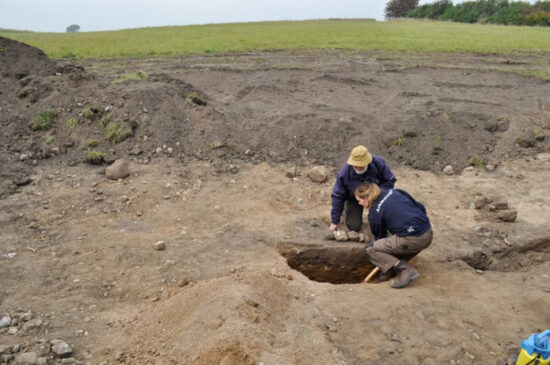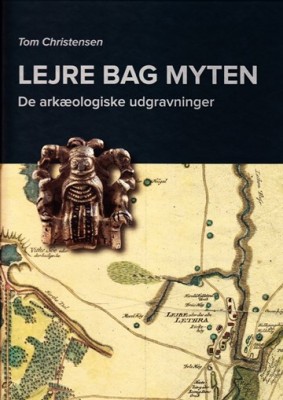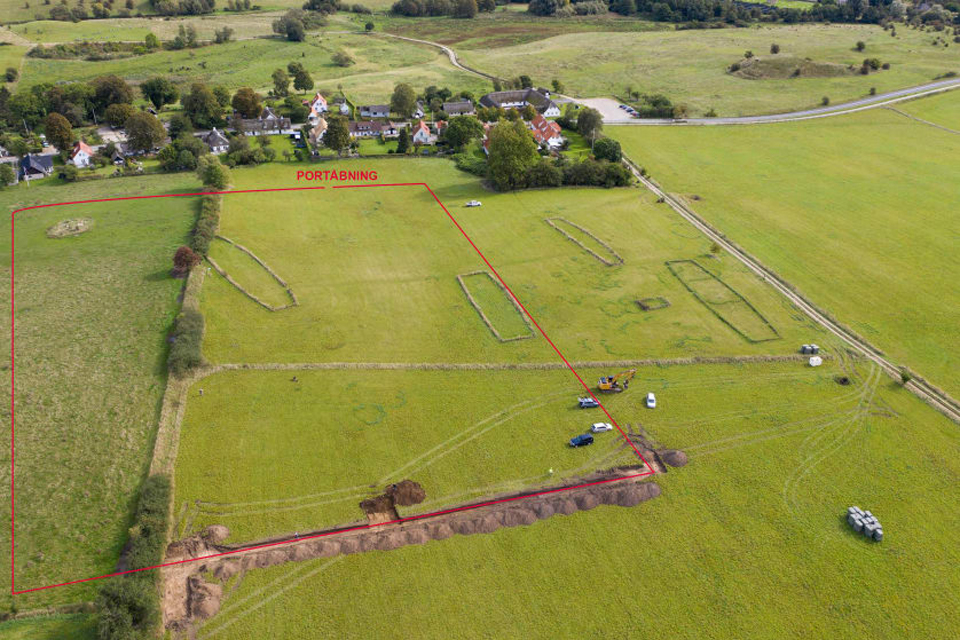The great halls at Lejre – by myth linked to the royal dynasty of the Scyldingas , Skjöldungar – continues to amaze. Holding the largest hall ever excavated, the complex was fenced-in by an impressive palisade. Recently the gate was discovered.

Yesterday, archaeologists from Roskilde Museum, ROMU, in cooperation with the National Museum in Copenhagen revealed their most recent discovery: the opening in the palisade that surrounded Lejre’s impressive royal hall during the Viking Age. The location of the approximately six-meter wide entrance emphasizes that the King’s Hall and the whole complex as a massive demonstration of power.
In connection with previous investigations, the palisade constructed of massive posts had been uncovered in several places. Until now the full extension of the palisade as well as the port was unknown.
Recently archaeologists decided to carry out a minor exploration of the palisade, a decision, which resulted in the discovery of the opening.
– It is an essential part of the puzzle to locate the opening in the palisade. The entry point opens up to a better understanding of what the site looked like when in use. However, it was not easy to locate as nothing is left of the original wooden posts or construction. What we have been looking for are slight nuances in the layers of soil. Despite the difficulties, we nevertheless have located the entrance. At the same time, we now know the extent of the entire palisade, tells archaeologist Julie Nielsen, ROMU’s general manager of the excavation.
A demonstration of power
The opening was located on the eastern side of the palisade down towards the present Lejre village, which continues to be situated just up from the river. Precisely this location at the bottom of the slope emphasizes that the entrance led into a mighty and powerful centre – a King’s Hall.
– You have to imagine it as a vivid scenographic layout that helped to stage the kingly power, explains project researcher at the National Museum, Tom Christensen, who for three decades has been responsible for the archaeological excavations at Lejre.
– We knew in advance that the main hall was not only located on the hilltop but also raised further up onto an artificial plateau. Now, we also know that the entrance to the whole complex was located below, at the lowest point possible. Thus, the king’s hall, which was whitewashed and visible from afar, must have towered above visitors, who entered into the courtyard of the royal residence through the impressive six-metre wide gate flanked by massive posts, he concludes.
As so often in research, however, each new find leads to further questions. Why would anybody construct a six-metre wide gate in a massive palisade otherwise constructed to look like an impressive piece of defensive work? Otherwise, such a wide opening should have been regarded as a disadvantage? And further: exactly how was the gate constructed? All questions that the archaeologists hope shortly to answer.
Facts:
– Modern archaeological excavations in Lejre have been going on for periods since the end of World War II
– The excavations have so far revealed, inter alia:
– Three residential areas with a total of seven impressive half-buildings, which over a period of over 500 years (500-1000 AD) have replaced one another
– The palisade, which surrounds the largest royal hall, measures 190 x 150 m, a total area of 25,000 m2
– In addition, several rich finds of metal objects, preferably iron, bronze and silver scattered over the settlement areas, have been found in close cooperation with volunteer metal detectorists.
The current excavations are being carried out by ROMU’s archaeologists in cooperation with the National Museum’s research project, Viking Dynasties. This project focuses on the connection between the royal seats at Lejre in Zealand and Uppsala in central Sweden from c. 500 – 1000 and is undertaken as a collaboration between Lejre and Uppsala. The project is initiated and funded by the Krogager Fonden. A publication is currently underway.
SOURCE:
Porten til “Skjoldungernes Kongsgård” fundet. Press Release
READ:
 Lejre bag myten. De arkæologiske udgravninger.
Lejre bag myten. De arkæologiske udgravninger.
By Tom Christensen
Romu/Jysk Arkæologisk Selskab 2015
ISBN: 978 87 88415 96 4
Lejre beyond the Legend – the Archaeological Evidence
By Tom Christensen
In: Siedlungs- and Küstenforschung im südlichen Nordseegebiet (2010) Vol. 33, pp.237 -254.

Ed by John D. Niles
Arizona Studies in the Middle Ages and the Renaissance (ASMAR 22)
Brepols 2007
